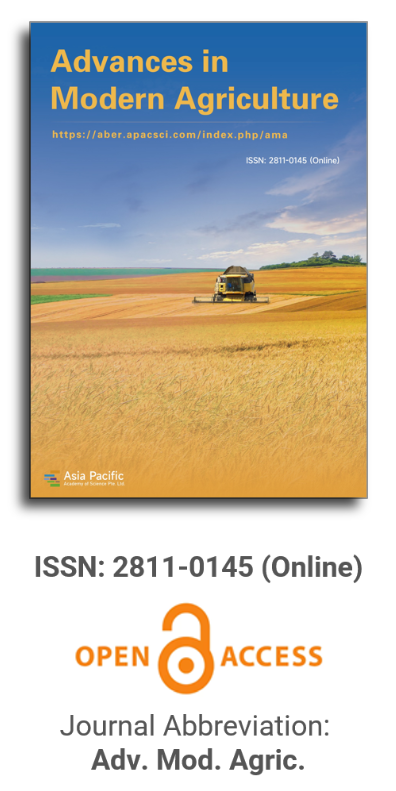


Water droplet distribution for non-circular sprinkler nozzles
Vol 4, Issue 1, 2023
VIEWS - 3479 (Abstract)
Download PDF
Abstract
Objective: The study sought to investigate the distribution law of the diameter, velocity, and kinetic energy of water droplets in specially designed nozzles. Method: An indoor windless water droplet dispersion test on the PY15 rocker-arm sprinkler was performed using a video raindrop spectrometer at five working pressures: 100 kPa, 150 kPa, 200 kPa, 250 kPa, and 300 kPa. Result: The equal-flow nozzle has the following range: circle > rhombus > ellipse; the shape coefficient of the special-shaped nozzle decreases with increasing outlet diameter and increases with increasing aspect ratio; the diameter of the rhombus nozzle’s water droplet increases radially. Conclusion: Under the same working pressure, the diameter of the water droplet at the end decreases as the form coefficient increases. The wider the outlet’s diameter, the longer the range and the greater the increase in the velocity of the water droplets. The larger the aspect ratio, the shorter the range and the greater the average diameter and velocity of the droplets. The elliptical nozzle has the lowest droplet velocity increase as droplet diameter increases. The impacting kinetic energy and growth range of water droplets per unit volume at the same position decrease as the pressure increases. Along the radial direction, the droplet velocity and diameter are logarithmic, while the droplet kinetic energy and diameter are exponential and linear functions. The relationship between the shape coefficient, outlet diameter, aspect ratio, and droplet distribution characteristics of the shaped nozzle can be simulated using the fitting coefficients of the three droplet distribution prediction models, all of which are above 0.9.
Keywords
References
- Bao Y, Liu J, Liu X, et al. Experimental study on effects of pressure on water distribution model of low-pressure sprinkler (Chinese). Journal of Drainage and Irrigation Machinery Engineering 2016; 34(1): 81–85.
- Li J, Xu Z. Research on water-saving irrigation in the development of facility horticulture: Review of “water-saving irrigation technology” (Chinese). Journal of Irrigation and Drainage 2020; 39(1): 146.
- Zhu X, Shi Y, Hu G, et al. Dynamic simulation and test of water distribution of fluidic sprinkler (Chinese). Journal of Irrigation and Drainage 2020; 39(4): 74–83.
- Yuan S, Li H, Wang X. Status, problems, trends and suggestions for water-saving irrigation equipment in China (Chinese). Journal of Drainage and Irrigation Machinery Engineering 2015; 33(1): 78–92.
- Wu P, Zhu D, Lv H, et al. Introduction to Irrigation Hydraulics (Chinese). Chinese Science Publishing & Media Ltd.; 2012.
- Tu Q, Li H, Wang X, et al. Comparison and selection of small-scale irrigation machines with multiple sprinklers based on grey relational analysis (Chinese). Journal of Jiangsu University (Natural Science Edition) 2014; 35(6): 656–662.
- Xu H, Gong S, Jia R, Liu X. Study on droplet size distribution of ZY sprinkler head (Chinese). Journal of Hydraulic Engineering 2010; 41(12): 1416–1422.
- Sánchez Burillo G, Delirhasannia R, Playán E, et al. Initial drop velocity in a fixed spray plate sprinkler. Journal of Irrigation and Drainage Engineering 2013; 139(7): 521–531.
- Gong X, Zhu D, Zhang L, et al. Drop size distribution of fixed spray-plate sprinklers with two-dimensional video disdrometer (Chinese). Transactions of the Chinese Society for Agricultural Machinery 2014; 45(8): 128–133+148.
- Lorenzini G. Water droplet dynamics and evaporation in an irrigation spray. Transactions of the ASABE 2006; 49(2): 545–549.
- Ouazaa S, Burguete J, Paniagua MP, et al. Simulating water distribution patterns for fixed spray plate sprinkler using the ballistic theory. Spanish Journal of Agricultural Research 2014; 12(3): 850. doi: 10.5424/sjar/2014123-5507
- Zhu X, Liu X, Liu J, et al. Droplet kinetic energy distribution regulation of complete fluidic sprinkler (Chinese). Transactions of the Chinese Society of Agricultural Engineering 2015; 31(15): 26–31.
- Chen C, Yuan S, Li H, Wang C. Effect of non-circle nozzle on hydraulic performance of impact variable-rate sprinkler (Chinese). Transactions of the Chinese Society for Agricultural Machinery 2011; 42(12): 111–115.
- Li D, Lu X, Zhao X. Experimental study on low pressure jet characteristic of the non-circle jet nozzle (Chinese). Light Industry Machinery 2006; 24(3): 18–20.
- Zhou X, Li H, Jiang Y. Study on water distribution uniformity of non-circular nozzles at low pressure (Chinese). Journal of Drainage and Irrigation Machinery Engineering 2017; 35(5): 448–453.
- Jiang Y, Li H, Hua L, et al. Experimental study on jet breakup morphologies and jet characteristic parameters of non-circular nozzles under low-intermediate pressures. Applied Engineering in Agriculture 2019; 35(4): 617–632. doi: 10.13031/aea.13291
- Wu P, Zhu D, Lv H, Zhang L. Hydraulics problems in farmland irrigation (Chinese). Journal of Drainage and Irrigation Machinery Engineering 2012; 30(6): 726–732.
Supporting Agencies
Copyright (c) 2023 Jialing Liu, Jixiang Wan, Hao Li, Yue Jiang
License URL: https://creativecommons.org/licenses/by/4.0/

This site is licensed under a Creative Commons Attribution 4.0 International License (CC BY 4.0).

Prof. Zhengjun Qiu
Zhejiang University, China

Cheng Sun
Academician of World Academy of Productivity Science; Executive Chairman, World Confederation of Productivity Science China Chapter, China
Indexing & Archiving
In the realm of modern agriculture, the integration of cutting-edge technologies is revolutionizing the way we approach sustainable farming practices. A recent study published in Advances in Modern Agriculture titled "Classification of cotton water stress using convolutional neural networks and UAV-based RGB imagery" has garnered significant attention for its innovative approach to precision irrigation management. Conducted by researchers from Institute of Data Science and the AgriLife Research and Extension Center of Texas A&M University (authors's information is below). This study introduces a novel method for classifying cotton water stress using unmanned aerial vehicles (UAVs) and convolutional neural networks (CNNs), offering a powerful solution for optimizing water use in agriculture.
Modern agricultural technology is evolving rapidly, with scientists collaborating with leading agricultural enterprises to develop intelligent management practices. These practices utilize advanced systems that provide tailored fertilization and treatment options for large-scale land management.
This journal values human initiative and intelligence, and the employment of AI technologies to write papers that replace the human mind is expressly prohibited. When there is a suspicious submission that uses AI tools to quickly piece together and generate research results, the editorial board of the journal will reject the article, and all journals under the publisher's umbrella will prohibit all authors from submitting their articles.
Readers and authors are asked to exercise caution and strictly adhere to the journal's policy regarding the usage of Artificial Intelligence Generated Content (AIGC) tools.
Asia Pacific Academy of Science Pte. Ltd. (APACSCI) specializes in international journal publishing. APACSCI adopts the open access publishing model and provides an important communication bridge for academic groups whose interest fields include engineering, technology, medicine, computer, mathematics, agriculture and forestry, and environment.



.jpg)
.jpg)

.jpg)
